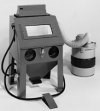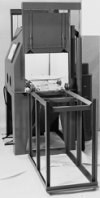So, You Want to Try Abrasive Blasting
Here are some questions to ask before you buy...
Share
Read Next
Surface preparation can be one of the greatest challenges of many projects.From preparation for paint to etching glass, abrasive blasting is becoming one of the most popular methods of surface preparation. The ease of the process, the absence of chemicals and the finish quality account for its popularity. Chances are good that once you research all of the available ways to do your next project, you will find that abrasive blasting is a promising choice. Once you choose abrasive blasting, the next step is to find the equipment. It may just be easier and less expensive than you think.
How do you decide what kind of equipment to buy? Where should you buy it? What is the difference between this brand and that brand? Why does this one cost less? These are some of the questions most people ask when they start shopping for many things. When shopping for a sandblaster, these questions are important; however, there are other questions you need to ask to insure that the equipment meets your needs.
What are you planning to blast?
Your answer may vary from bridges to bricks or fenders to stamping dies or cylinder heads to etching a design on a trophy. Each application has different equipment needs and uses different abrasives. For example, if you are blasting a bridge in preparation for painting, you would need a large portable pressure pot. You would use an inexpensive abrasive that you would not worry about recovering. On the other side, if you are rebuilding automotive engines, you would want an enclosed cabinet with a recyclable abrasive.
This article will concentrate on enclosed blast cabinets because this type of equipment is becoming the most widely used by both amateurs and professionals.
What size blast cabinet do I need?
To answer this question you need to look into the future. If you will always be blasting the same parts, the answer is easy. You just have to be sure there is enough room in the cabinet and that the cabinet fits in the allotted space. However, if there is a good chance that you may blast larger parts in the future, you should size your cabinets accordingly. While blast equipment is reasonably priced in comparison to the work it does, it is still an investment that should be well planned.
If you are blasting parts small enough to fit in your hand, and that is all you blast, there are small bench-top models to fit your needs. However, if you are blasting large, heavy stamping dies, you will need a larger cabinet with a heavy weight capacity and possibly a turntable to help maneuver the part around in the cabinet.
Once you decide how large your cabinet must be, you must ask another question.
How large of a blast gun will my compressor handle?
The air requirements of sandblast guns are determined by a combination of the air jet and the blast nozzle. This measurement is calculated in cubic feet per minute (cfm).
Compressors are rated at a given cfm at a given pressure or psi. For example, 12 cfm at 90 psi or 14.5 cfm at 90 psi. Some compressor manufacturers rate their equipment by horsepower (hp). This can be deceiving because compressors rated at a given hp can differ in their actual cfm output, depending on the components of the compressor pump itself.
Because compressors are expensive investments, many sandblast equipment manufacturers have various size blast guns available with different cfm ratings. It is recommended that when you choose a blast gun, you give yourself an additional 10 to 20% cfm to allow for nozzle wear.
When a large blast nozzle wears, it increases the air requirements. Blast guns are available in different sizes and with nozzles and air jets made of different materials. Some common materials that nozzles are made of are steel, ceramic, tungsten carbide and boron carbide. The difference in these materials will determine the life of the nozzle.
When blasting with aluminum oxide, a steel nozzle will be quickly destroyed. A ceramic nozzle blasting with the same material will last one to four hours, depending on the pressure used. This compares to 20 to 40 hours with a tungsten carbide nozzle or 200 to 1,000 hours with a boron carbide nozzle. As with most things, more longevity brings a higher price. Considering price and wear life, tungsten carbide is the most popular of these.
What do I look for concerning cabinet quality and features?
Although most blast cabinets look similar, they may be constructed differently. Keep in mind that the conditions inside a blast cabinet are very destructive. Because of this, it is extremely important that the cabinet materials and fabrication methods withstand this harsh punishment. If the material is too thin or lightweight, it will wear through more quickly than a heavier gauge metal will. Also, cabinets manufactured of thinner, lightweight materials will not support heavier parts. It is recommended that cabinet walls be constructed of at least 14-gauge steel and that cabinet legs be at least 11-gauge steel.
It could be dangerous if you were to overload a cabinet and have it collapse while you are operating it. Another important factor is how the seams are fabricated. A cabinet that is riveted or screwed together will not have the strength of one that is fully welded. Also, seams that are riveted or screwed will loosen over time and begin to leak dust, resulting in a dirty and unsafe work area. Welded seams do not leak.
Some cabinet manufacturers design the cabinets with only side-loading doors. While this is fine in some circumstances, it can be inconvenient for long or heavy parts. Some applications require working with heavy or bulky parts that must be loaded with a forklift, an overhead crane or just two people lifting an object into the cabinet. To accommodate this, some manufacturers build cabinets that are called flip-tops or clamshells. With this design, the entire upper level of the cabinet is hinged at the back, completely opening to the level of the work surface.
Because the top is heavy, it should be attached to a counter-balance system that allows the top to be opened easily. This, along with a side door to load small parts, is the best of both worlds.
Another important feature to look at is the lighting. Because the atmosphere inside the cabinet is so harsh, you need to protect the lighting fixtures as well as possible. The best and safest solution to this problem is to mount the lights outside of the work area. This way they are protected from the abrasive action and do not take up space inside the work area.
Chances are you will be blasting for an extended time, so you want to be sure that the blast gun is lightweight and comfortable to hold. Squeezing a trigger to operate the gun can be quite a strain and even cause a repetitive motion injury so a foot pedal operated gun is important.
To insure that the operator is not accidentally blasted, be sure there is a safety mechanism on the opening that disables the gun when the door or lid is open.
To control the finish, you will need a regulator and gage. These should be mounted where the operator can easily reach them. Some manufacturers include this as a standard feature. An in-line air filter is necessary, especially in humid climates. Without it, your blasting media will clump up like mud. This is great for building sandcastles, but makes a real mess inside the pickup tube and blast gun.
Once you have decided on the cabinet, determine what accessories are included with your purchase and what can be retrofitted. Some optional accessories include turntables, tumble baskets, dust blow-off guns and pencil guns.
Do I need a dust collector?
When blasting, the result of abrasive media slamming into its target creates dust and debris that quickly fills the airspace within the cabinet. Before long, you will find that you cannot even see your work. Soon you will find that because there is such a high volume of air entering the cabinet from the blast nozzle that dust will start pouring out of every opening.
To stop the dust problem, it is necessary to attach a dust collector to the cabinet. The dust collector must be sized properly for the size or volume of the cabinet itself and for the cfm rating of the blast gun inside the cabinet. If you are blasting extremely dusty objects such as rust or scale, this also must be considered. The larger the cabinet, the larger the dust collector you will need. Some manufacturers include a properly sized dust collector with the blast cabinet. Others only offer dust collectors as options.
Do not make the mistake of getting a dust collector with a "cheap" motor. These are not vacuums; they are dust collectors. In most cases, a filter-bag-style dust collector is the best choice. The bag-type filters are low cost and are quite durable and low maintenance. In some applications where a very clean work area is mandatory, such as in a lab, I recommend that a cartridge-style filter be used. While cartridge filters require greater maintenance, they filter more completely. For example, a bag filter may remove particles to 50 microns, while a cartridge filter can remove particles to 0.5 micron.
There is also a reclaim-type dust-collection system. This hooks up to the bottom of the cabinet hopper and draws the used abrasive into a unit called a cyclone. The cyclone swirls the used abrasive around like a small tornado, allowing the heavy abrasive particles to drop to the bottom with the lighter dust particles being drawn out of the top into a dust collector. The clean abrasive at the bottom is then recycled through the blast gun. When using hard abrasives like aluminum oxide or silicon carbide, this can make your abrasive media last longer, lowering your operating costs.
Surface preparation can be a great challenge. You need to research all of your options, including sandblasting. It can give a quality finish and it just may be easier and less expensive than you think.
Read Next
Alkaline Cleaning Guide
Gregg Sanko, Senior Chemist, Oakite Products, Inc. provides an overview of the alkaline cleaning process.
Read MoreThe Best Tape for High-Temperature Applications
High-temperature tapes are designed with maximum heat ratings indicating the highest temperature they can withstand for a very short time.
Read More


























